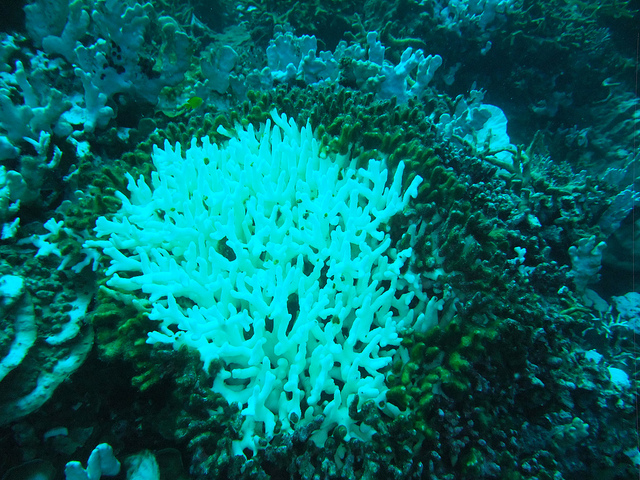Corals might be adapting to climate change – University of Colorado Boulder

Report on Coral Resilience and its Implications for Sustainable Development Goals
1.0 Executive Summary
This report analyzes recent scientific findings regarding the resilience of coral organisms to ocean acidification. The research, published in Science Advances, indicates that certain corals possess an adaptive mechanism to continue skeletal growth despite increasing ocean acidity. This analysis places these findings within the framework of the United Nations Sustainable Development Goals (SDGs), with a primary focus on SDG 14 (Life Below Water) and SDG 13 (Climate Action). While the study offers a hopeful signal of natural resilience, it simultaneously underscores the severe and multifaceted threats corals face from climate change, pollution, and other anthropogenic stressors, reinforcing the urgency of global action to achieve sustainability targets.
2.0 Research Findings on Coral Adaptation
A study conducted by a researcher at CU Boulder examined long-lived coral skeletons from the Great Barrier Reef and the Coral Sea. The research utilized advanced imaging technology, Raman spectroscopy, to analyze the chemical and molecular structure of skeletons dating back nearly 200 years. This application of innovative scientific methods directly supports the aims of SDG 9 (Industry, Innovation, and Infrastructure) by advancing our understanding of critical ecosystems.
- Corals were observed to regulate the chemistry of their internal calcifying fluid.
- This internal regulation allowed them to maintain conditions suitable for the formation of their calcium carbonate skeletons.
- This adaptive capability persisted despite a documented gradual increase in ocean acidity since the Industrial Revolution.
- The findings suggest that some corals can sustain skeletal growth even when the surrounding seawater chemistry becomes less favorable.
3.0 Implications for SDG 14: Life Below Water
The health and survival of coral reefs are central to achieving SDG 14, which aims to conserve and sustainably use the oceans, seas, and marine resources. The research has direct implications for several targets under this goal.
- Target 14.3: Minimize and Address Ocean Acidification. The study provides critical insight into the biological response of corals to ocean acidification. Understanding these adaptive mechanisms is vital for modeling future ecosystem impacts and developing conservation strategies.
- Target 14.2: Sustainably Manage and Protect Marine and Coastal Ecosystems. Corals are the foundation of reef ecosystems, which support immense biodiversity. The potential for resilience, however limited, is a key factor in the long-term viability of these ecosystems. The report notes that weaker skeletons could trigger a “broader ecological collapse,” jeopardizing this target.
- Target 14.1: Prevent and Reduce Marine Pollution. The article warns that corals face a combination of stressors, including human-induced pollution. The resilience observed against acidification may not extend to the cumulative impact of pollution, warming, and other pressures, highlighting the need for integrated management approaches.
4.0 The Overarching Threat and the Link to SDG 13: Climate Action
The primary driver of the threats facing corals is global climate change, making SDG 13 (Climate Action) inextricably linked to the fate of marine ecosystems. The report emphasizes that any natural resilience is being tested by unprecedented environmental change.
- Ocean Acidification: The ocean has absorbed approximately 30% of anthropogenic CO2 emissions, directly causing a 40% increase in surface ocean acidity since the Industrial Revolution. This is a direct consequence of inaction on climate change.
- Sea Surface Temperatures and Coral Bleaching: The report highlights that warming sea temperatures are a more immediate and severe threat, causing mass coral bleaching. Scientists confirmed bleaching events in at least 62 countries and territories between 2023 and mid-2024.
- Urgency for Climate Action: The research findings do not diminish the urgent need to combat climate change. Coral resilience has limits, and without significant global efforts to reduce greenhouse gas emissions, even the most adaptable species face extinction.
5.0 Broader Connections to the Global Sustainability Agenda
The health of coral reefs reverberates beyond the ocean, connecting to other critical Sustainable Development Goals.
- SDG 11 (Sustainable Cities and Communities): Coral reefs serve as natural infrastructure, protecting coastlines from erosion and storm damage. The structural integrity of their skeletons is therefore essential for the resilience and safety of coastal communities. A decline in reef health compromises this vital ecosystem service.
6.0 Conclusion and Future Outlook
The discovery of an adaptive mechanism in corals provides a valuable insight into their biology but should not be misinterpreted as a solution to the coral crisis. The pressures of climate change and pollution continue to escalate, overwhelming the natural resilience of these vital ecosystems. To safeguard coral reefs and the communities that depend on them, a committed and integrated global response is necessary.
- Further long-term research is required to determine if this adaptive response is widespread across different coral species and geographic locations.
- Immediate and ambitious action on SDG 13 is paramount to reduce the primary stressors of ocean warming and acidification.
- Efforts to achieve SDG 14 must continue, focusing on reducing direct pressures such as pollution and unsustainable fishing practices to give corals the best possible chance of survival.
SDGs, Targets, and Indicators in the Article
1. Which SDGs are addressed or connected to the issues highlighted in the article?
-
SDG 14: Life Below Water
- This goal is central to the article, which focuses on the health and resilience of corals, described as “the foundation of ocean biodiversity.” The entire text discusses the threats to marine ecosystems, specifically coral reefs in the Great Barrier Reef and the Coral Sea, from ocean acidification, warming temperatures, pollution, and unsustainable fishing. The potential for a “broader ecological collapse” directly relates to the goal of conserving and sustainably using marine resources.
-
SDG 13: Climate Action
- The article explicitly links the threats to corals with climate change. It states, “Corals, the foundation of ocean biodiversity, are threatened by climate change.” It identifies ocean acidification as a direct consequence of increased carbon dioxide emissions (“The ocean absorbs about 30% of carbon dioxide emissions from human activities”), and also mentions “warming sea surface temperatures” as a cause of mass coral bleaching. The research into coral resilience is a response to these climate-related impacts.
2. What specific targets under those SDGs can be identified based on the article’s content?
-
Under SDG 14 (Life Below Water):
- Target 14.2: “By 2020, sustainably manage and protect marine and coastal ecosystems to avoid significant adverse impacts, including by strengthening their resilience…” The article’s core subject is the resilience of coral ecosystems to environmental stressors. The research investigates whether corals “might be more resilient than previously thought” and how they “adjust and continue to generate their hard, stony skeleton structures,” which is directly related to strengthening ecosystem resilience.
- Target 14.3: “Minimize and address the impacts of ocean acidification, including through enhanced scientific cooperation at all levels.” The study is a prime example of scientific work aimed at understanding and addressing the impacts of ocean acidification. The research showing that corals “were able to regulate the mechanism they use to build and maintain their skeletons despite the ocean becoming more acidic” contributes directly to the body of knowledge needed to address this target.
- Target 14.1: “By 2025, prevent and significantly reduce marine pollution of all kinds…” The article mentions that corals face stress from “human-induced pollution,” identifying it as a key threat alongside climate change.
-
Under SDG 13 (Climate Action):
- Target 13.1: “Strengthen resilience and adaptive capacity to climate-related hazards and natural disasters in all countries.” The research explores the innate resilience and adaptive capacity of a natural system (coral reefs) to a major climate-related hazard (ocean acidification). The article also notes that coral reefs “protect shorelines threatened by erosion and storm damage,” highlighting their role in strengthening the resilience of coastal areas to climate-related disasters.
3. Are there any indicators mentioned or implied in the article that can be used to measure progress towards the identified targets?
-
Ocean Acidity Levels (pH)
- This is a direct indicator for Target 14.3. The article explicitly mentions the “gradual increase in ocean acidity levels over the past 200 years” and that “ocean acidity has increased by 40% since the Industrial Revolution.” Measuring this change is crucial for tracking the problem of ocean acidification.
-
Prevalence of Coral Bleaching
- This serves as an indicator for the overall health of coral ecosystems (Target 14.2). The article provides a specific metric: “Between 2023 and mid-May 2024, scientists have confirmed mass coral bleaching in at least 62 countries and territories worldwide.” This data point is a clear measure of the stress on coral reefs due to factors like high ocean temperatures.
-
Rate of Coral Skeleton Growth (Calcification)
- This is an implied indicator for measuring coral resilience and health (Targets 14.2 and 13.1). The study focuses on whether corals can “continue to generate their hard, stony skeleton structures” and “sustain the production of calcium carbonate.” The rate and quality of this growth are key metrics for assessing their ability to cope with environmental changes.
-
Coral Skeleton Density
- This is another implied indicator of coral health. The article notes the prediction that ocean acidification would lead to “less dense structures that are more prone to breakage.” The study’s use of Raman spectroscopy to analyze the molecular structure and “chaos of the coral skeleton” suggests that density and structural integrity are key variables for measuring the impact of environmental stressors.
4. Summary Table of SDGs, Targets, and Indicators
| SDGs | Targets | Indicators |
|---|---|---|
| SDG 14: Life Below Water | Target 14.3: Minimize and address the impacts of ocean acidification. | Ocean Acidity Levels (pH). |
| SDG 14: Life Below Water | Target 14.2: Sustainably manage and protect marine and coastal ecosystems to avoid significant adverse impacts, including by strengthening their resilience. | Prevalence of Coral Bleaching. |
| Rate of Coral Skeleton Growth (Calcification). | ||
| Coral Skeleton Density. | ||
| SDG 14: Life Below Water | Target 14.1: Prevent and significantly reduce marine pollution. | Levels of “human-induced pollution” (mentioned as a threat, but specific metrics are not provided in the article). |
| SDG 13: Climate Action | Target 13.1: Strengthen resilience and adaptive capacity to climate-related hazards. | Ability of corals to regulate internal chemistry as a measure of adaptive capacity. |
Source: colorado.edu

What is Your Reaction?
 Like
0
Like
0
 Dislike
0
Dislike
0
 Love
0
Love
0
 Funny
0
Funny
0
 Angry
0
Angry
0
 Sad
0
Sad
0
 Wow
0
Wow
0
















































/environment-climate-change-and-health-(ech)/water-sanitation-hygiene-and-health-(wsh)/landfill-tuvalu-36092.tmb-1200v.jpg?sfvrsn=5c21fe40_1#)

.jpg.webp?itok=0ZsAnae9#)

























